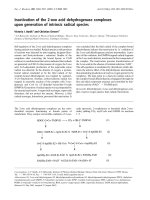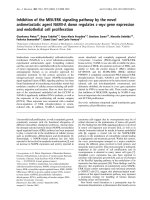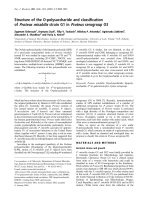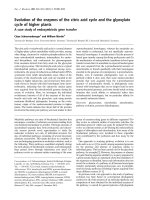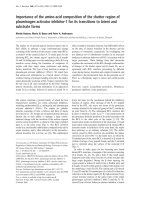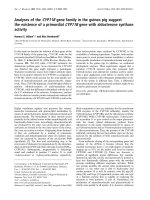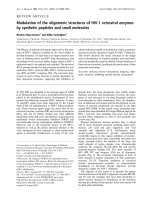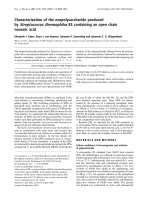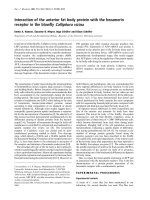Báo cáo Y học: Inactivation of the Na+-translocating NADH:ubiquinone oxidoreductase from Vibrio alginolyticus by reactive oxygen species pot
Bạn đang xem bản rút gọn của tài liệu. Xem và tải ngay bản đầy đủ của tài liệu tại đây (256.66 KB, 6 trang )
Inactivation of the Na
+
-translocating NADH:ubiquinone
oxidoreductase from
Vibrio alginolyticus
by reactive oxygen species
Julia Steuber
1
, Miche
`
le Rufibach
1
,Gu¨ nter Fritz
2
, Frank Neese
3,
* and Peter Dimroth
1
1
Mikrobiologisches Institut der Eidgeno
¨
ssischen Technischen Hochschule, ETH-Zentrum, Zu
¨
rich, Switzerland;
2
Biochemisches Institut, Universita
¨
tZu
¨
rich, Switzerland;
3
Mathematisch-naturwissenschaftliche Sektion, Fachbereich Biologie,
Universita
¨
t Konstanz, Germany
The Na
+
-translocating NADH:quinone oxidoreductase
(Na
+
-NQR) from Vibrio alginolyticus was inactivated by
reactive oxygen species. Highest Na
+
-NQR activity was
observed i n anaerobically pre pared membranes that exhi-
bited 1 : 1 coupling of NADH oxidation and Q reduction
activities (1.6 UÆmg
)1
). Optical a nd EPR s pectroscopy
documented the presence of b-type cytochromes, a [2Fe)2S]
cluster and an organic radical s ignal in anaerobically pre-
pared membranes from V. alginolyticus. It is shown that the
[2Fe)2S] cluster previously assigned to the Na
+
-NQR ori-
ginates from the succinate dehydrogenase or the related
enzyme fumarate reductase.
Keywords: electrochemical sodium gradient; reactive oxygen
species; Vibrio;Na
+
transport; NADH: quinone oxido-
reductase.
The marine bacterium Vibrio alginolyticus possesses a
Na
+
-translocating NADH:Q oxidoreductase (Na
+
-
NQR) that maintains an electroc hemical sodium gradient
required for nutrient uptake and motility [ 1–5]. This
respiratory sodium pump contains one Fe–S cluster,
noncovalently bound FAD, covalently bound FMN and
ubiquinone-8 as redox cofactors [2,6–8] that are likely to
participate in N ADH oxidation, e lectron transfer, Na
+
transport and Q reduction. Sequence analysis of the six
subunits of the Na
+
-NQR from V. alginolyticus (NqrA–
NqrF) showed that only the NqrF (or b-) subunit
comprises a cysteine motif (Cys69, Cys75, Cys78 and
Cys110) required f or ligation of one Fe–S cluster [3,4].
Tightly bound ubisemiquinones were proposed to play a
central role during the redox-linked Na
+
transport by the
Na
+
-NQR [6,9,10]. The translocation of Na
+
through the
protein matrix is thought to be dependent on ion -pair
formation of a positively charged Na
+
cation with a
negatively charged ubisemiquinone anion generated in a
medium of low dielectric [4,10]. This hypothesis was
supported b y t he detection of an NADH-induced radical
signal in aerobic samples of the Na
+
-NQR from
V. alginolyticus by EPR spectroscopy [6]. However, th e
high concentration of the radical (13 l
M
) compared to the
[2Fe)2S] cluster (3 l
M
), together with the observat ion that
the Na
+
-NQR produced superoxide radicals in the
presence of NADH and O
2
, strongly suggested that the
overstoichiometric formation of radicals was due to
oxidative damage of the enzyme. The identification of the
individual redox cofactors of coupled Na
+
-NQR is a
prerequisite to understand the mechanism of r edox-linked
Na
+
transport. Here we show that the Na
+
-NQR is
already inactivated in the membrane-bound state if the
cells are disrupted in the presence of dioxygen, resulting in
an uncoupling of N ADH oxidation and Q reduction
activities. It is also demonstrated that the [2Fe)2S] cluster
previously assigned to the Na
+
-NQR [6] originates from
the succinate dehydrogenase or the related fumarate
reductase.
MATERIALS AND METHODS
Preparation of membrane vesicles for EPR spectroscopy
V. alginolyticus (DSM 2171
T
, Braunschweig, Germany)
was grown aerobically in a 300-L fermenter a s described
previously [6]. Frozen cells (20 g) were washed with
anaerobic e xtraction buffer (10 m
M
Hepes/KOH, pH 7.5,
5m
M
Mg
2
SO
4
,0.2
M
K
2
SO
4
) a nd resuspended in the
presence of a trace of DNAse (2–4 mL extraction buffer per
g cells). The cells were broken by a single passage through a
French press at 80 MPa. The crude extract eluting from the
French press was collected under a stream of N
2
.All
subsequent manipulations were carried out in the anaerobic
chamber under a n atmosphere of N
2
/H
2
(95/5%). 50 m
M
EDTA (potassium salt) was added to the crude extract, and
the membrane vesicles were sedimented by ultracentrifuga-
tion. Membranes were washed once in extraction buffer
containing 10 m
M
EDTA. Subsequently, complexed Mn
2+
was removed by a second and a third washing step with
10 m
M
Hepes/KOH, pH 7.5 containing 0.2
M
K
2
SO
4
.
EDTA treatment did not diminish the Na
+
-NQR activity
of the membrane vesicles that were stimulated by Na
+
Correspondence to J. Steuber, Mikrobiologisches Institut der
Eidgeno
¨
ssischen Technischen Hochschule, ETH-Zentrum,
Schmelzbergstr. 7, CH-8092 Zu
¨
rich, Switzerland.
Fax: + 41 1 6321148, Tel.: + 41 1 6323830,
E-mail:
Abbreviations: Q1, ubiquinone-1; Na
+
-NQR, Na
+
-translocating
NADH:ubiquinone oxidoreductase; TTFA, 2-thenoyltrifluoro-
acetone; MTT, 3-(4,5-dimethyl 2-thiazolyl) 2,5-diphenyl
tetrazolium bromide.
*Present address: Max-Planck Institut fu
¨
r Strahlenchemie,
D-45470 Mu
¨
lheim an der Ruhr, Germany.
Dedication: Dedicated to Achim Kro
¨
ger on the occasion
of his 65th b irthday.
Note: A web site is available at http:// www.micro.biol.ethz.ch
(Received 7 November 2001, accepted 8 January 2002)
Eur. J. Biochem. 269, 1287–1292 (2002) Ó FEBS 2002
ions by a f actor of t hree (specific Q reductase activity in
100 m
M
KCl, 0.6 lmolÆmin
)1
Æmg
)1
;in100m
M
NaCl,
2.1 lmolÆmin
)1
Æmg
)1
). The membrane v esicles were resus-
pended in extraction buffer to a final protein concentration
of 42 mg mL
)1
. Membrane v esicles (0.3 mL) were mixed
with substrates (NADH, succinate, fumarate in H
2
O,
potassium salts) or inhibitor (thenoyltrifluoroacetone in
ethanol) as indicated and transferred to EPR tubes in t he
anaerobic chamber.
Analytical methods and spectroscopy
Na
+
was determined by atomic absorption spectroscopy
with a Shimadzu AA-646 spectrometer. Protein was deter-
mined b y the bicinchoninic acid me thod [11]. If not
mentioned otherwise, NADH:Q oxidoreductase assays [8]
were performed at 25 °C in sealed cuvettes filled in the
anaerobic chamber and flushed with N
2
.Inorderto
investigate the influence of dioxygen and NADH on the
activity of the Na
+
-NQR, membrane vesicles were prepared
(A) in the presence of dioxygen without additions (B) with
300 UÆmL
)1
superoxide dismutase and 40 UÆmL
)1
catalase
(C) w ith 10 m
M
pyruvate and 20 UÆmL
)1
L
-lacate dehy-
drogenase (D) under exclusion of dioxygen without further
additions. Succinate dehydrogenase activity was followed
by the reduction of 3-(4,5-dimethyl 2-thiazolyl) 2,5-diphenyl
tetrazolium bromide (MTT) at 560 nm (e
560
¼
12.1 m
M
)1
Æcm
)1
) in the presence of phenazine methosulfate
[12]. Visible spectra of membranes were recorded on a
Shimadzu UV-3000 spectrophotometer in the difference
spectrum mode. X-band EPR spectra were obtained with a
Bruker ESP300 spectrometer with peripheral equipment
and data handling as previously described [13]. The spectra
were simulated with the program EPR [14]. Quantification
of the EPR signals was carried out by comparison with a
Cu
2+
standard [13].
RESULTS AND DISCUSSION
Inhibition and uncoupling of the Na
+
-NQR
activity by dioxygen
In the presence of NADH and dioxygen, the purified Na
+
-
NQR from V. alginolyticus was inactivated with a half time
of approximately 3 min. This decrease in enzymatic activity
correlated with the formation of superoxide radicals,
indicating a superoxide-mediated destruction of the enzyme
[6]. We reasoned that the Na
+
-NQR might be already
inactivated during the aerobic disruption of the cells due to
the presence of NADH i n the crude extract. In order to test
this hypothesis, French press cell rupture and preparation of
membrane vesicles of V. alginolyticus cells were performed
under exclusion of dioxygen. In addition, the effect of
enzymes that detoxify reactive oxygen species (superoxide
dismutase and catalase) on the Na
+
-NQR activity during
aerobic cell rupture was investigated. In another experiment,
the concentration of NADH in the aerobically prepared
crude extract was diminished by the action o f l actate
dehydrogenase plus p yruvate. Both the NADH dehydro-
genase and the ubiquinone-1 (Q1) reduction activities of
membranes were followed in order to determine the degree
of uncoupling of the enzyme. The term ÔuncouplingÕ
describes the observation that the electrons derived from
the oxidation of NADH by the Na
+
-NQR are not comp-
letely transferred to the substrate, Q1. Instead, dioxygen
seems to act as electron acceptor at an unspecified site of the
enzyme to yield superoxide radicals. The highest specific Q
reductase activi ty was foun d in anaerobically prepared
membranes t hat exhibited 1 : 1 coupling of NADH dehy-
drogenase and Q r eduction activities (1.6 lmolÆminÆmg
)1
;
Table 1 ). The lowest Q r eductase activity was observed in
membranes p repared aerobically without any a dditions
(0.6 lmolÆmin
)1
Æmg
)1
). Removal of superoxide or NADH
in aerobically prepare d crude extracts and membranes
resulted in increased Q reductase activities, but the uncou p-
ling o f N ADH oxidation from Q reduction could not be
prevented by these measures (Table 1). It is concluded that
the Na
+
-NQR is already inactivated in the membrane-
bound state if the cells are disrupted in the presence of
dioxygen, resulting in an uncoupling of NADH oxidation
and Q reduction activities. The uncoupling of the
Na
+
-NQR activity in membranes by aerobic cell rupture
was not restricted to the French press procedure,
but was also observed with the more gentle osmotic
shock protocol described by Tokuda & Unemoto, with
NADH oxidation and Q reduction activities of 2.45 and
0.99 lmolÆmin
)1
Æmg
)1
, respectively [15].
Characterization of redox cofactors in membranes
from
V. alginolyticus
Based on the results of Table 1, the Na
+
-NQR is partially
inactivated during cell rupture in the presence of dioxygen.
Superoxide radicals that are generated during the oxidation
of reduced electron carriers by O
2
apparently cause this
inhibition. For example, the fumarate reductase from
Escherichia coli produces superoxide in air [16]. Optical
and EPR spectroscopic investigations were performed to
Table 1. Inhibition and uncoupling of the Na
+
-NQR activities in membranes from V. alginolyticus by dioxygen and NADH. The enzymic activities of
membranes were determined a s described in Materials and methods with Q1 as electron acceptor in the presence of NaCl. With membranes
prepared un der aerobic conditions, the assay was performed aerobically. With anaerobically prepared membranes, the activity was determined
under exclusion of air. ND, not determined.
Conditions of cell rupture
NADH oxidation
(lmolÆmin
)1
Æmg
)1
)
Q1 reduction
(lmolÆmin
)1
Æmg
)1
)
Ratio of NADH oxidation/
Q1 reduction activity
+O
2
1.7 0.6 2.8
+O
2
/superoxide dismutase/catalase 3.2 1.2 2.7
+O
2
/lactate dehydrogenase/pyruvate (4.7)
a
0.9 ND
–O
2
1.6 1.6 1.0
a
The high NADH oxidation activity is due to the presence of residual
L
-lactate dehydrogenase and pyruvate.
1288 J. Steuber et al. (Eur. J. Biochem. 269) Ó FEBS 2002
characterize the redox enzymes present in V. alginolyticus
membranes and to d etermine their redox state. The optical
difference spectrum of washed membranes from V. algino-
lyticus prepared under exclusion of dioxygen (as isolated
minus air-oxidized, Fig. 1) revealed the presence of reduced
b-type cytochromes with absorption maxima at 526, 531,
557 and 5 61 nm. No further reduction of the b-t ype
cytochromes upon addition of dithionite was achieved. In
addition, reduction of air-oxidized membranes with NADH
or dithionite did not increase the amount of reduced b-type
cytochromes compared to membranes prepared under
exclusion of dioxygen (not shown). From their characteristic
a-andb-absorption maxima, the redox complexes succinate
dehydrogenase, or fumarate reductase (557 nm and
526 nm) [17] and the cytochrome bo-type ubiquinol oxidase
(561 nm and 531 nm) [18] were assigned. Based on the
extinction coefficient of the succinate d ehydrogenase from
E. coli [12], the amount of b-type cytochromes associated
with succinate dehydrogenase or fumarate redu ctase in
V. alginolyticus membranes was 1.3 lmolÆmg protein
)1
.The
succinate dehydrogenase activity of membranes was
0.2 lmolÆmin
)1
Æmg
)1
. The presence of a succinate dehy-
drogenase or fumarate reductase in membranes from
V. alginolyticus was also c onfirmed b y E PR spectroscopy
showing the typical resonances of partially reduced center I,
the [2Fe)2S] cluster of succinate dehyd rogenase, o r fuma-
rate reductase, with g
x,y,z
¼ 1.92, 1.93, 2.03 (Fig. 2, traces A
and B). N o further r eduction was achieved upon the
addition of succinate (Fig. 2, trace B). Furthermore, an
organic radical signal at g ¼ 2.005 was detected. Upon
addition of NADH to membranes prepared under exclusion
of dioxygen, there was a twofold increase in intensity of a
near-axial signal with resonances at g
x,y
¼ 1.92, 1.93 (Fig. 2,
trace C). Addition of 80 m
M
Na
+
did not alter the NADH-
induced EPR signals measured at 40 K and 2 mW (Fig. 2,
trace D ). Note that the residual Na
+
concentration of
washed membrane vesicles was 3–4 m
M
. Addition of Na
+
had no obvious effect on the NADH-induced radical s ignal
measured at 70 K and 4 lW ( not shown). No additional
signals due to [4Fe)4S] clusters were observed at 4 K (see
below). These results are very similar to those reported f or
membranes from V. alginolyticus prepared in air [6]. In this
study, the NADH-induced signal at g % 1.93 was assigned
to the [2Fe)2S] cluster of the Na
+
-NQR, and the strong
radical signal to ubisemiquinone bound to the Na
+
-NQR.
However, addition of NADH in the presence of thenoyltri-
fluoroacetone (TTFA), a specific inhibitor of succinate
dehydrogenase and fumarate reductase, prevented the
increase in signal intensity in the g % 1.93 region (Fig. 3).
This result clearly d emonstrates that the NADH-induced
g % 1.93 EPR s ignal observed by Pfenninger-Li et al.[6]
was due to the reduced center I, the [2Fe)2S] cluster in
succinate dehydrogenase, or in fumarate reductase.
We also investigated the EPR spectrum of the g ¼ 2.005
signal at 70 K and 4 lW in the presence of TTFA and
fumarate. Under these conditions, the addition of NADH
did not lead to any detectable effect (not shown), suggesting
that the radical signal is not due to ubisemiquinone bound
to the Na
+
-NQR, as p roposed previously [6]. The radical
might be associated with cofactors of other respiratory
complexes, such as t he flavosemiquinone in succinate
dehydrogenase or fumarate reductase [17]. TTFA blocks
the electron t ransfer between the Fe–S centers of succinate
dehydrogenase, or fumarate reductase, and the quinone
pool. Both complexes exhibit a lmost identical EPR spec-
troscopic properties [17]. As V. alginolyticus is capable of
anaerobic growth, the fumarate reductase is likely to be
Fig. 1. Optical difference spectrum of membranes from V. alginolyticus.
The spectrum shows the difference in absorbance of membranes pre-
pared under exclusion of dio xygen (Ôas iso late dÕ) minus the air-oxidized
membranes. The protein concentration was 10 mgÆmL
)1
.
Fig. 2. Electron paramagnetic resonance spectra of membranes from
V. alginolyticus. Trace A sho ws the EPR spectrum of anaerobically
prepared membranes, as isolated. Trace B, membranes plus 40 m
M
succinate, 80 m
M
Na
+
, 360 m
M
K
+
trace C , membranes plu s 8 m
M
NADH, 4 m
M
Na
+
,450m
M
K
+
; trace D, membranes plus
8m
M
NADH, 80 m
M
Na
+
,380m
M
K
+
; (final concentrations). The
membranes were incubated with substrates for 4–5 min prior to
freezing in liquid N
2
. The protein c oncentration was 4 2 mgÆmL
)1
.EPR
parameters: microwave frequency, 9.652 GHz; microwave power,
2 mW; modulation amplitude, 1 mT; temperature 40 K.
Ó FEBS 2002 Na
+
-translocating NQR from V. alginolyticus (Eur. J. Biochem. 269) 1289
present under limiting O
2
concentrations at high cell
densities in batch culture. Addition of NADH to mem-
branes shifts the redox potential towards more negative
values and increases the concentration of ubiquinol
compared to succinate-reduce d membranes. Higher quinol
concentrations allow the reduction of fumarate reductase
that unlike succinate dehydrogenase c annot be completely
reduced by succinate [17]. As a consequence, an increase in
signal intensity of the reduced center I of fumarate reduc-
tase in NADH- compared to succinate-reduced membranes
might occur, as shown in F ig. 2 . By s ubtracting the EPR
spectrum of succinate-treated membranes from the spec-
trum obtained in the presence of NADH, center I of the
fumarate reductase (or succinate dehydrogenase) was erro-
neously assigned to the Na
+
-NQR [6].
The amount of center I of succinate dehydrogenase, or
fumarate red uctase, in membranes from V. alginolyticus
was e stimated by simulation o f the EPR spectrum of
NADH-treated membranes using the parameters
g
x,y,z
¼ 1.92, 1.935, 2.029, width (x,y,z) ¼ 1.2, 1.0, 1.2 mT
(Fig. 4). These parameters are based on the EPR spectro-
scopic properties of center I, which are remarkably similar
in all succinate dehydrogenases and fumarate reductases
[17]. The amount of center I (1.0 lmolÆmg protein
)1
)in
membra nes from V. alginolyticus determined by EPR
spectroscopy compares favorably with the amount of b-
type cytochromes associated with succinate dehydrogenase,
or fum arate reductase, as determined by optical spectros-
copy (1.3 lmolÆmg
)1
).
Detection of succinate dehydrogenase or fumarate
reductase in the partially purified Na
+
-NQR
The NADH-induced g % 1.93 EPR signal that was erro-
neously assigned to the membrane-bound Na
+
-NQR was
also observed in the partially purified Na
+
-NQR obtained
by anionic exchange chromatography [6]. This g % 1.93
EPR signal found in the enriched Na
+
-NQR also origin-
ated from reduced center I of succinate dehydrogenase, or
fumarate reductase. The presence of fumarate reductase in
analiquotoftheNa
+
-NQR preparation analysed by EPR
spectroscopy [6] was confirmed b y immunostaining u sing
antiserum raised against the 66-kDa flavoprotein subunit
(FrdA) of fumarate reductase from E. coli [17]. Figure 5
shows a Western Blot of the partially purified Na
+
-NQR
analysed by EPR spectroscopy and membranes from E. coli
grown on glycerol and fumarate. The antiserum raised
against E. coli FrdA detected a polypeptide with an
apparent molecular mass of 66 kDa in the Na
+
-NQR
and in the E. coli membranes. A second cross-reactive
polypeptide with lower molecular mass in the E. coli
membranes probably represents a proteolytic fragmen t of
the FrdA subunit [19]. The stoichiometry and localization of
the flavin cofactors of the Na
+
-NQR are a matter of debate
[7,20]. A contamination of t he Na
+
-NQR with FrdA that
contains a covalently bound FAD [8a-N(3)-histidyl-FAD]
will result in an overestimation of covalently bound flavin in
partially purified Na
+
-NQR preparations.
A comparison of the EPR spectra of the Na
+
-NQR
from different purification stages further supports the
assumption that the NADH dehydrogenase activity and
the Fe–S cluster are properties of two distinct proteins, the
Na
+
-NQR and the fumarate reductase or related succi-
nate dehydrogenase. The oxidation of NADH is catalysed
by the NqrF subunit o f the Na
+
-NQR. This subu nit
contains a FAD cofactor and a Cys-(X)
5
-Cys-(X)
2
-Cys
motif that ligates a Fe–S cluster. N o additional cysteine-
rich motifs that i ndicate the presence of F e–S clusters are
found on the remaining Nqr subunits, NqrA–NqrE [4].
An increase of the specific NADH d ehydrogenase ac tivity
upon purification of the Na
+
-NQR is therefore expected
to be accompanied by an increase in the amount of
Fig. 3. Electron paramagnetic resonance spectra of membranes from
V. alginolyticus in the presence of TTF A. TTF A is a specific i nhib itor o f
succinate dehydrogenase, or fumarate reductase, that prevents the
complete reduction of center I. Upper trace, membranes plus 40 m
M
fumarate, 2 m
M
TTFA; lower trace, membranes p lus 40 m
M
fumarate,
2m
M
TTFA, 8 m
M
NADH (final concentrations). The protein
concentration was 44 mg mL
)1
. EPR parameters as in Fig. 2.
Fig. 4. Experimental (upper trace) and simulated (lower trace) electron
paramagnetic resonance spectrum of center I in NADH-reduced mem-
branes from V. alginolyticus. EPR parameters: microwave frequency,
9.652 GH z; microwave power, 0.126 m W; modulation amplitude,
1 mT; temperature 4 K. Simulation parameters: g
x,y,z
¼ 1.92, 1.935,
2.029, width (x,y,z) ¼ 1.2, 1.0, 1.2 mT.
1290 J. Steuber et al. (Eur. J. Biochem. 269) Ó FEBS 2002
[2Fe)2S] cluster. However, purification of the Na
+
-NQR
led to a loss of the Fe–S EPR signal (Table 2). In the
Na
+
-NQR obtained after gel filtration that exhibited the
highest NADH dehydrogenase activity, no Fe–S cluster
could be detected by EPR spectroscopy. We monitored
the s uccinate d ehydrogenase activity in fractions enriched
in NADH:quinone oxidoreductase during the purification
of the Na
+
-NQR according t o [6]. In p arallel with a
decrease in signal intensity o f the Fe–S cluster, there was a
decrease in the specific succinate dehydrogenase activity
(Table 2). No succinate dehydrogenase activity was
observed in t he Na
+
-NQR purified by gel filtration.
These data clearly show that the Fe–S cluster observed in
fractions enriched in Na
+
-NQR [6] is identical to center I
of fumarate reductase (or s uccinate dehydrogenase).
CONCLUSIONS
To our knowledge, this study demonstrates for the first time
that a purification procedure under strict exclusion of
dioxygen will be an absolute prerequisite to obtain a realistic
picture of the coupling o f NADH:Q oxidoreduction to
Na
+
transport by the Na
+
-NQR from V. alginolyticus.
The succinate dehydrogenase and/or fumarate reductase are
major respiratory complexes present in V. alginolyticus
membranes that impede the d etection of the Fe–S cluster of
the Na
+
-NQR in the membrane-bound state by EPR
spectroscopy.
ACKNOWLEDGEMENTS
This work was supported by a grant from the commission of research,
ETH, to J. S. We t hank S. Albracht, University of Amsterdam, for
valuable discussions, and P. Kroneck, for using the EPR facilities at the
University of Konstanz. Antiserum against the E. coli fumarate
reductase flavoprotein subunit was a generous gift from G. Cecchini,
VA Medical Center, San Francisco.
REFERENCES
1. Tokuda, H. (1993) The Na
+
cycle in Vibrio alginolyticus.InAlkali
Cation Transport Systems in Prokaryotes (Bakker, E.P., ed.),
pp. 125–138. CRC Press, Boca Raton.
2. Unemoto, T. & Hayashi, M. (1993) Na
+
-translocat in g N ADH-
quinone reductase of marine and halophilic bacteria. J. Bioenerg.
Biomembr. 25, 385–391.
3. Rich, P.R., Meunier, B. & Ward, F.B. (1995) Predicted structure
and possible ionmotive mechanism of the sodium-linked NAD-
ubiquinone oxidoreductase of Vibrio alginolyticus. FEBS Lett .
375, 5–10.
4. Steuber, J. (2001) Na
+
translocation by bacterial NADH:quinone
oxidoreductases: an extension to the complex I-family of primary
redox pumps. Biochim. Biophys. Acta 1505, 45–56.
5. Nakayama, Y., Hayashi, M. & Unemoto, T. (1998) Identification
of six subunits constituting Na
+
-translocating NADH-quinone
reductase from the marine Vibrio alginolyticus. FEB S Lett. 422,
240–242.
Fig. 5. Detection of fumarate reductase in the Na
+
-NQR analysed by
EPR spectroscopy. The arrow indicates the FrdA flavoprotein subunit
of fumarate reductase present in E. coli membranes (10 lg) and in the
Na
+
-NQR (10 lg) after Q-Sepharose chromatography.
Table 2. Succinate dehydrogenase activity and amount of reduced [2Fe)2S] cluster (center I) detected in the Na
+
-NQR at different p urifica tion stage s.
The Na
+
-NQR was purified according to [6]. The nearly axial g % 1.93 EPR signal of a reduced [2Fe)2S] c luster (center I of succinate
dehydrogenase or fumarate reductase) p resent in the Na
+
-NQR was quantified as described previously [6]. ND, not detected.
Purification step
NADH dehydrogenase activity
(lmolÆmin
)1
Æmg
)1
)
Succinate
dehydrogenase activity
(lmolÆmin
)1
Æmg
)1
)
Amount of reduced [2Fe)2S]
(l
M
spin concentration)
Membranes 1.2 0.2 40
DEAE Sephacel 14 0.05 2.8
Q Sepharose 88 0.02 1.4
Superdex 200 120 0 ND
Ó FEBS 2002 Na
+
-translocating NQR from V. alginolyticus (Eur. J. Biochem. 269) 1291
6. Pfenninger-Li, X.D., Albracht, S.P.J., Belzen, R.V. & Dimroth, P.
(1996) The NADH:ubiquinone oxidoreductase of Vibrio algino-
lytic us: p urificatio n, properties and recon stitution of the N a
+
pump. Biochemistry 35, 6233–6242.
7. Nakayama, Y., Yasui, M., Sugahara, K., Hayashi, M. &
Unemoto, T . (2000) Covalently b ound flavin i n the NqrB an d
NqrC subunits of Na
+
-translocating NADH-quinone reductase
from Vibrio alginolyticus. FEBS Lett. 474, 165–168.
8. Steuber, J., Krebs, W. & Dimroth, P. (1997) The Na
+
-trans-
locating NAD H:ubiquinon e o xidoreductase from Vibrio algino-
lytic us: redox states of the FAD prosthetic group and mechanism
of Ag
+
inhibition. Eur. J. Biochem. 249, 770–776.
9. Hayashi, M. & Unemoto, T. (1984) Characterization of the
Na
+
-dependent respiratory chain NADH:quinone oxidoreduc-
tase of the marine bacterium, Vibrio alginolyticus,inrelationtothe
primary Na
+
pump. Biochim. Biophys. Acta 767, 470–478.
10. Dimroth, P. (1997) Primary so dium io n translocating enzym es.
Biochim. Biophys. A cta 1318, 11–51.
11. Smith, P.K., Krohn, R.I., Hermanson, G.T., Mallia, A.K.,
Gartner, F.H., Provenzano, M.D., Fujimoto, E.K., Goeke, N.M.,
Olson, B.J. & Klenk, D.C. (1985) Measurement of protein using
bicinchoninic acid. Anal. Biochem. 150, 76–85.
12. Kita, K., Vibat, C.R.T., Meinhardt, S., Guest, J.R. & Gennis,
R.B. (1989) One-step purification from Escherichia coli of complex
II (succinate: ubiquinone oxidoreductase) associated with succi-
nate-reducible cytochrome b
556
. J. Biol. Chem. 264, 2672–2677.
13. Neese, F., Zumft, W.G., Antho line, W.E. & K roneck , P.M .H.
(1996) The purple mixed-valence Cu
A
center in nitrous oxide
reductase: EPR of the copper-63-, copper-65-, and both copper-65
and [ N-15
ÆÆ
] h istidine-enriched e nzyme and a m olecul ar orbital
interpretation. J. Am. Chem. Soc. 118, 8692–8699.
14. Neese, F. (1995) The program EPR. Quant. Chem. Progr. Exch.
Bull. 136,5.
15. Tokuda, H. & Unemoto, T. (1984) Na
+
is translocated at
NADH:quinone oxidoreductase segment in the respiratory ch ain
of Vibrio alginolyticus. J. Biol. Chem. 259, 7785–7790.
16. Imlay, J.A. (1995) A metabolic enzyme that rapidly produces
superoxide, fumarate reductase of Escherichia coli. J. Biol. Chem.
270, 19767–19777.
17. Ackrell, B.A.C., Johnson, M.K., Gunsalus, R.P. & Cecchini, G.
(1992) Structure a nd function of succinate dehydrogenase and
fumarate reductase. Chemistry and Biochemistry of Flavoenzymes
(Mu
¨
ller, F., ed.), pp. 229–297. CRC Press, Boca Raton.
18. Miyoshi-Akiyama, T., Hayashi, M. & U nemoto, T. (1993)
Purification and properties of cytochrome bo-type ub iquinol
oxidase from a marine bacterium Vibrio alginolyticus. Biochim.
Biophys. Acta 1141, 283–287.
19. Luna-Chavez, C., Iverson, T.M., Rees, D.C. & C ecchini, G. (2000)
Overexpression, purification, and crystallization of the membrane-
bound fumarate reductase from Escherichia coli. Prot. Expres.
Purif. 19, 188–196.
20. Zhou, W., Bertsova, Y.V., Feng, B., Tsatsos, P., Verkhovskaya,
M.L., Gennis, R.B., Bogachev, A.V. & Barquera, B. (1999)
Sequencing and preliminary characterizatio n of the N a
+
-trans-
locating NADH:ubiquinone oxidoreductase from Vibrio harveyi.
Biochemistry 38, 16246–16252.
1292 J. Steuber et al. (Eur. J. Biochem. 269) Ó FEBS 2002
